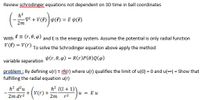Question

Transcribed Image Text:Review schrodinger equations not dependent on 3D time in ball coordinates
(
v² +V(f) )v(F) = E Þ(*)
2m
With = (r, 0, 9) and E is the energy system. Assume the potential is only radial function
V(*) = V(r) To solve the Schrodinger equation above apply the method
p(r, 0, q) = R(r)P(0)Q(9)
variable separation
problem : By defining u(r) = rR(r) where u(r) qualifies the limit of u(0) = 0 and u(--) = Show that
fulfilling the radial equation u(r)
h? d?u
h? l(l + 1)
+(V(r) +
2m
u = Eu
2m dr2
r2
Expert Solution
This question has been solved!
Explore an expertly crafted, step-by-step solution for a thorough understanding of key concepts.
Step by stepSolved in 2 steps with 2 images

Knowledge Booster
Similar questions
- (a) Show that the terms in Schrödinger’s equation have the same dimensions. (b) What is the common SI unit for each of these terms?arrow_forwardConsider the 1D time-independent Schrodinger equation ħ² ď² 2m dr² with the potential where to is a parameter. (a) Show that V(x) = +V(x)] = Ev v is a solution of the Schrodinger equation. ħ² mx² sech² 1 = A sech x xo (₁)arrow_forwardShow the relation LxL = iħL for the quantum mechanical angular momentum operator Larrow_forward
- Show that ? (x,t) = A cos (kx - ?t) is not a solution to the time-dependent Schroedinger equation for a free particle [U(x) = 0].arrow_forwardComplete the derivation of E = Taking the derivatives we find (Use the following as necessary: k₁, K₂ K3, and 4.) +- ( ²) (²) v² = SO - #2² - = 2m so the Schrödinger equation becomes (Use the following as necessary: K₁, K₂, K3, ħ, m and p.) 亢 2mm(K² +K ² + K² v k₁ = E = = EU The quantum numbers n, are related to k, by (Use the following as necessary: n, and L₁.) лħ n₂ π²h² 2m √2m h²²/0₁ 2m X + + by substituting the wave function (x, y, z) = A sin(kx) sin(k₂y) sin(kz) into - 13³3). X What is the origin of the three quantum numbers? O the Schrödinger equation O the Pauli exclusion principle O the uncertainty principle Ⓒthe three boundary conditions 2² 7²4 = E4. 2marrow_forwardconsider an infinite square well with sides at x= -L/2 and x = L/2 (centered at the origin). Then the potential energy is 0 for [x] L/2 Let E be the total energy of the particle. =0 (a) Solve the one-dimensional time-independent Schrodinger equation to find y(x) in each region. (b) Apply the boundary condition that must be continuous. (c) Apply the normalization condition. (d) Find the allowed values of E. (e) Sketch w(x) for the three lowest energy states. (f) Compare your results for (d) and (e) to the infinite square well (with sides at x=0 and x=L)arrow_forward
arrow_back_ios
arrow_forward_ios